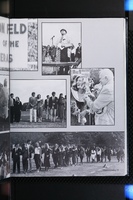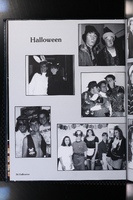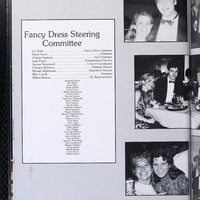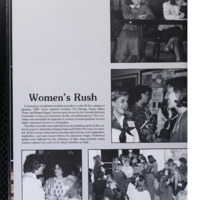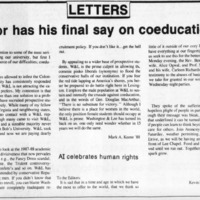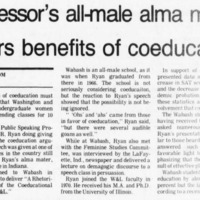The 1980s at Washington and Lee University marked a period of significant cultural shift, moving away from the more overtly sexualized portrayals of women of the previous decade. In 1985, the university reached a historic milestone by officially becoming co-educational, signifying a transformative step towards a more inclusive environment. During this time, university publications like The Calyx and the Ring-Tum Phi began to reflect a changing narrative in the representation of women, one that aligned more with conservative values, yet also laid the groundwork for the emergence of women's autonomy and independence.
1980s
The Shifting Dynamics of the 1980s: From Escort to Autonomy
Images from events such as homecoming and Halloween in 1989 show women dressed in modest attire, participating equally alongside men in university traditions. The era's publications often portrayed women in the company of men, yet with a sense of belonging and active involvement rather than as mere accompaniments. This suggested a nuanced shift towards a conservative yet inclusive campus culture.
The Fancy Dress Steering Committee list from 1989 reveals women taking on significant organizational roles. Despite the conservative backdrop, women were actively involved in leadership, demonstrating the beginning of a push towards gender parity in campus involvement.
The introduction of sorority life provided a new social framework for women on campus. The Women's Rush image from the late 80s illustrates the vibrant participation of women in these newly established spaces, fostering a sense of community and sisterhood that empowered female students.
The transition period in the '80s also witnessed debates and discussions around coeducation. Articles and opinion pieces in campus newspapers presented varying perspectives on this change, with some echoing traditional sentiments while others advocated for the benefits of a coeducational environment.
A poignant opinion piece titled "Coeds are not liberal" from this decade encapsulates the complexity of the time, where the author argues against the assumption that the presence of women would inherently liberalize the campus. It reflects a growing awareness of women's diverse political and social beliefs and their right to define their own values and ideals.
The portrayal of women in the '80s was a balance between maintaining traditional values and navigating the shifting currents towards gender equality and individualism. The images and narratives of the time reflected a cultural conversation that was still rooted in historical norms but was progressively acknowledging women's autonomy and capacity for self-determination.
As Washington and Lee University edged towards coeducation, the portrayal of women during the 1980s evolved from being predominantly in the company of men towards showcasing their independent roles in the university's social, academic, and organizational life. The decade laid the foundation for the transformative years that would follow, with women increasingly depicted as autonomous individuals, no longer secondary to their male counterparts but as equals in shaping the university's future.
